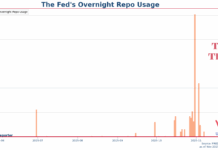The Bank of England on Thursday released its latest Monetary Policy Report, announcing its decision to lower its policy rate by 25 bps to 4%. The report contains a lot of excellent analysis, including on the recent rise in food prices, the effect of trade war as well as a review of its quantitative tightening policy.
The QT review is a good read and contains a lot of important information. For example, it notes that the Bank’s estimate of the QT’s impact on gilt yield has increased. It also confirms that the British central bank may take into account the QT’s effect on financial conditions when it sets interest rate policy. But one thing, a comparatively much less important thing, in the review just stuck in my mind: The BoE mentioned
“For instance, the Federal Reserve has indicated that shrinking its balance sheet through QT is an active monetary policy tool (December 2021 FOMC minutes), in contrast to the MPC’s principles outlined above.”
This just doesn’t feel right. I don’t think the Federal Reserve ever treat QT as an active policy tool. What’s even stranger is that I reread the Dec 2021 FOMC minutes and couldn’t find any relevant passage to support the Bank’s claim.
To make sure I was not looking at the wrong places, I emailed BoE’s media contact, and they told me the line refers “particularly [to] the ‘Discussion of Policy Normalization Considerations’ section” of the minutes.
This makes the whole thing even more stranger. This is not only because I still couldn’t find the passages indicating the Fed seeks to use QT as an “active” policy tool; but also because these sections in the FOMC minutes usually doesn’t contain many decision or much consensus. Instead, they generally express the Fed officials’ relevant discussions on the subjects,and vaguely indicate how many FOMC members support these ideas.
Let’s step back and check out what the BoE means by an “active monetary policy tool”. Here are the Bank’s “key principles” for how QT should be conducted.
First, the MPC has used Bank Rate as its active policy tool when adjusting the stance of monetary policy.
Second, sales have been conducted so as not to disrupt the functioning of financial markets, and only in appropriate market conditions.
Third, to help achieve that, sales have been conducted in a relatively gradual and predictable manner over a period of time.
In short, for the BoE, the Bank Rate is an active policy tool while the QT is not.
So, is it something very different from the Fed’s principles on QT? According to the US central bank’s Policy Normalization explainer, its QT principles are:
- The Committee views changes in the target range for the federal funds rate as its primary means of adjusting the stance of monetary policy.
- The Committee will determine the timing and pace of reducing the size of the Federal Reserve’s balance sheet so as to promote its maximum employment and price stability goals. The Committee expects that reducing the size of the Federal Reserve’s balance sheet will commence after the process of increasing the target range for the federal funds rate has begun.
- The Committee intends to reduce the Federal Reserve’s securities holdings over time in a predictable manner primarily by adjusting the amounts reinvested of principal payments received from securities held in the System Open Market Account (SOMA).
- Over time, the Committee intends to maintain securities holdings in amounts needed to implement monetary policy efficiently and effectively in its ample reserves regime.
- In the longer run, the Committee intends to hold primarily Treasury securities in the SOMA, thereby minimizing the effect of Federal Reserve holdings on the allocation of credit across sectors of the economy.
- The Committee is prepared to adjust any of the details of its approach to reducing the size of the balance sheet in light of economic and financial developments
To the Fed, target range of federal funds rate is its “primary” monetary policy tool, which, as we have just seen above, is very similar to the BoE’s principles. This is why I don’t understand what the BoE means when it says, “the Federal Reserve has indicated that shrinking its balance sheet through QT is an active monetary policy tool (December 2021 FOMC minutes), in contrast to the MPC’s principles outlined above.”
If we look a little deeper, the Fed came up with its principles during its January 2022 FOMC meeting, which is one meeting after the one the BoE cited. These principles are agreed by “all participants” following the conclusion of their discussions.
During the December 2021 meeting, even the statement that “it would likely be appropriate to initiate balance sheet runoff at some point after the first increase in the target range for the federal funds rate”, an obvious choice for the monetary policy strategy that was in Jan 2022 adopted by the Fed as one of the QT principles, was only agreed to by “[a]lmost all participants.”
So, maybe we should be looking at something suggested but not agreed by the whole FOMC?
Then maybe this line fits the criteria:
“Some participants commented that removing policy accommodation by relying more on balance sheet reduction and less on increases in the policy rate could help limit yield curve flattening during policy normalization.”
But the problem is very obvious — it is an opinion put forward by “some” FOMC members, not an agreed position by all the FOMC members, and was not adopted by the US central bank as its QT principles.
To Fed watchers, even self-qualified ones like myself, it should be obvious to treat the opinions held by “some” participants as not being supported by the majority of the FOMC, as otherwise they would more likely be described as being supported by “a majority of participants” or “almost all participants,” like the one we mentioned above.
The BoE tried to use this claim to show it’s hard to estimate QT’s effect internationally, as not all central banks do QT the same way. But framing QT as the Fed’s “active policy tool seems a strange and inaccurate way for the BoE to distinguish its own approach.
Do they need to hire a better Fed watch to support their research efforts?










